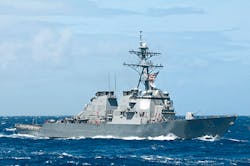NSC 2015: Righting the Ship – From the Worst to the Best
Former Commander Michael Abrashoff joked during the opening keynote at the National Safety Congress in Atlanta that he's not the smartest guy in the room, but don't let his modesty fool you. Abrashoff was smart enough to figure out how to turn one of the worst ships in the Navy - the USS Benfold – into one of the best. And he did it by talking.
There's a ceremony the Navy holds when one commander leaves and another takes his place. They can last as long as a couple of hours and usually are very solemn with longish speeches from the outgoing commander and new commander. When Abrashoff boarded the USS Benfold, he was struck by how dirty it was. He realized the ship had a crew that took no pride in being on that ship, a crew that probably wasn't combat-ready.
When the outgoing commander left, the crew actually applauded and cheered his leaving. "It was the most blatant show of disrespect I'd ever seen in the Navy," remembered Abrashoff, "and I didn't want that to happen to me in two years."
Abrashoff, like many business and safety leaders today, was limited in resources. "I can't choose the mission. I can't choose the people. I can't get more money. I'm not going to change the Navy," he remembers thinking. But he could do something.
One of Abrashoff's professional mentors was William Perry, the former U.S. Secretary of Defense. When Abrashoff left Perry's office to take command of the USS Benfold, Perry told him: "Assume your crew wants to do a good job. If you don't get the outcome you want, look inward to what you could have done differently."
Those words stuck with Abrashoff, who created an atmosphere of open communication on the ship. Rather than sit in his office, Abrashoff interviewed as many as seven crew members one-on-one every day – until he had spoken with all 310 of them. He asked what motivated them, what concerned them, what they would like to see changed and how they would change it.
"The only things they couldn't change were the Navy and the captain," joked Abrashoff.
He walked around, spoke with the crew and never stopped asking them what could be done better and safer. As one crew member pointed out to him, they had a different view of life on the ship than he did.
"This ship is a tree and we're all monkeys in that tree," the crew member said. "You're the monkey on the top branch, then the officers on another branch and all of us are on the bottom branch. When you look down, all you see are faces smiling up at you. When we look up, we have an ENTIRELY different view of the organization."
Often, said Abrashoff, the crew members had great solutions to issues facing them. All he had to do was ask.
For example, because of the wear and tear salt water took on the ship, it was painted – top to bottom – several times a year. Finally, a crew member, who was painting the boat for the umpteenth time, asked Abrashoff if he ever had painted his house. Abrashoff said he had. "Sucks, doesn't it?" responded the crew member. "And we're painting this ship every other month."
Abrashoff asked the crew member if he had a solution; after all, the USS Benfold had to look shipshape. "Have you ever heard of stainless steel?" the crew member asked. "Oh, you mean the stuff that doesn't rust?" Abrashoff replied.
All of the equipment was bolted down using bolts that rusted and caused streaking on the paint. They changed out as many as possible to aluminum at a cost of $25,000, and the paint jobs started lasting as long as 9 months.
When Abrashoff left the USS Benfold after his tour of duty, he treated the crew to a lobster and steak dinner, which he called the "last supper," and rather than spend as long as two hours on a ceremony to changeover command of the ship, Abrashoff uttered five words to the crew: "You know how I feel." He saluted his crew as he left the ship, because it was their effort that had turned things around.
Abrashoff said a crew member emailed him that "there wasn't a dry eye on the boat" after he left.
"We're all captains of our own ships. We're all leaders," Abrashoff reminded his audience. "Do you want to leave want tears when you go or cheers?"
About the Author

Sandy Smith
Sandy Smith is the former content director of EHS Today, and is currently the EHSQ content & community lead at Intelex Technologies Inc. She has written about occupational safety and health and environmental issues since 1990.
